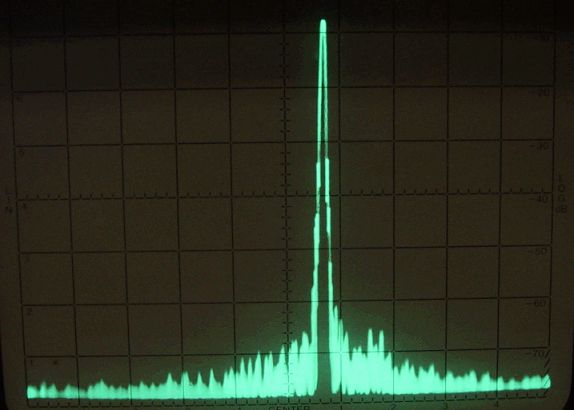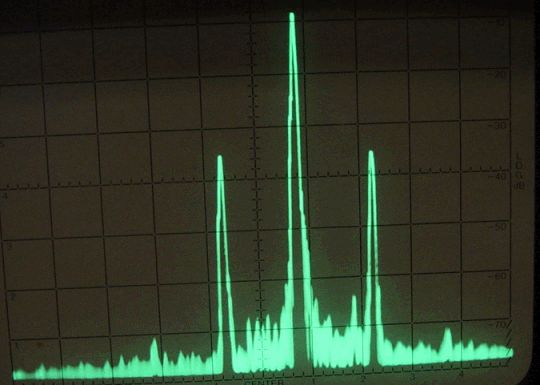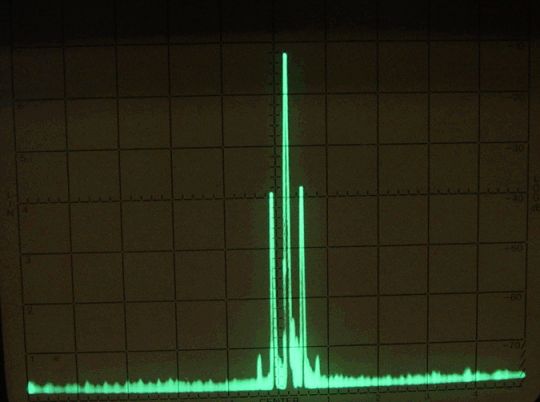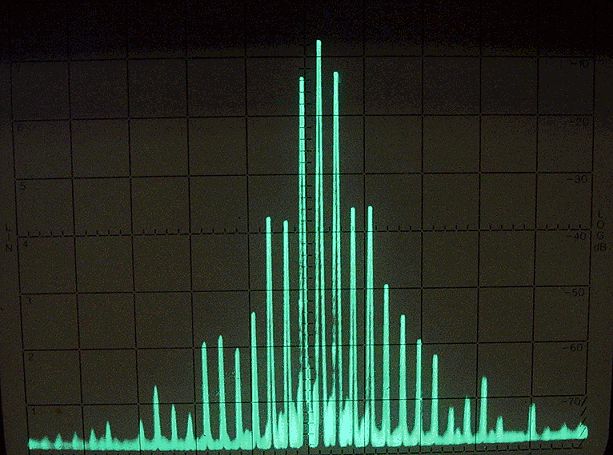Thought I'd post a little pictoral tutorial on AM modulation (and overmodulation). Many of you already know all this, but for those that don't, here's a brief primer on AM modulation.
An AM modulated signal (all regular CB radios use AM) consists of three basic parts. When you key your mic and are not talking, you are sending out a signal that has basically one frequency in it, IE the carrier signal. We'll take CB channel 21 for example. 21's frequency is 27.215 mhz. A photo of a spectrum analyzer display showing a carrier on channel 21 is shown below:

When you speak into your mic, the frequency of your voice is added to and subtracted from the frequency of the carrier, generating a group (or band) of sum and difference frequencies, called the upper and lower sidebands. We call them sidebands becuase they consist of more than one frequency, due to the fact that the human voice contains a number of harmonic frequencies (multiples of a fundemental, or base, frequency).
Below is a photo of the same signal above, but this time modulated by a signal of 3khz. You can plainly see the two sidebands to the left and right of the main carrier signal. The second picture below is the same signal, shown at a different resolution, so you can get a better idea of how narrow a proeprly modulated signal actually is. The total width of the signal shown is about 6khz, which is the width of the average CB channel (this width is determined by the receiver circuitry of the CB, and is designed to be only about 6khz wide to cut down on interference from adjacent channels).


The following photo is of the same signal, now overmodulated. You can see how much wider the signal has become, with interference being caused over many channels above and below channel 21. The cause of overmodulation is generally clipped limiters and other improper tune-up and power modifications. In the case of this particular radio, the limiter was purposely overdriven to show what happens.

Quite some time ago, there was a thread about who was best to tune a Galaxy radio. In that thread, I posted some more info on this topic. Click Here to visit that old thread. The post I'm referring to is about a third of the way down the page.
An AM modulated signal (all regular CB radios use AM) consists of three basic parts. When you key your mic and are not talking, you are sending out a signal that has basically one frequency in it, IE the carrier signal. We'll take CB channel 21 for example. 21's frequency is 27.215 mhz. A photo of a spectrum analyzer display showing a carrier on channel 21 is shown below:

When you speak into your mic, the frequency of your voice is added to and subtracted from the frequency of the carrier, generating a group (or band) of sum and difference frequencies, called the upper and lower sidebands. We call them sidebands becuase they consist of more than one frequency, due to the fact that the human voice contains a number of harmonic frequencies (multiples of a fundemental, or base, frequency).
Below is a photo of the same signal above, but this time modulated by a signal of 3khz. You can plainly see the two sidebands to the left and right of the main carrier signal. The second picture below is the same signal, shown at a different resolution, so you can get a better idea of how narrow a proeprly modulated signal actually is. The total width of the signal shown is about 6khz, which is the width of the average CB channel (this width is determined by the receiver circuitry of the CB, and is designed to be only about 6khz wide to cut down on interference from adjacent channels).


The following photo is of the same signal, now overmodulated. You can see how much wider the signal has become, with interference being caused over many channels above and below channel 21. The cause of overmodulation is generally clipped limiters and other improper tune-up and power modifications. In the case of this particular radio, the limiter was purposely overdriven to show what happens.

Quite some time ago, there was a thread about who was best to tune a Galaxy radio. In that thread, I posted some more info on this topic. Click Here to visit that old thread. The post I'm referring to is about a third of the way down the page.
